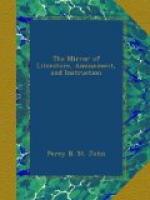* * * * *
THE CHLAMYPHORUS.
In our account of the Nine-banded Armadillo, at page 57 of the present volume, we noticed the curious fact of the whole series of armadillos offering a notable example of one genus being confined to a particular country, viz. South America; of their standing perfectly insulated, and exhibiting all the characters of a creation entirely distinct, and, except as to the general character of mammiferous quadrupeds, perfectly of its own kind.
The nearest resemblance to the armadillo is, we believe, to be traced in a very curious little quadruped which is occasionally to be seen in the district of Cuyo, at the foot of the Andes, on the eastern side. The first instance of its being brought to Europe was a specimen preserved in spirit, which was added to the Museum of the Zoological Society, about four years since, by the Hon. Capt. Percy, R.N. who received it from Woodbine Parish, Esq. British consul at Buenos Ayres. It had been previously known only by the figures and description given by Dr. Harlan, in the Annals of the Lyceum of Natural History of New York. His specimen was, however, deprived of the skeleton and internal parts, which are perfect in the specimen, in one of the lower rooms of the Museum in Bruton-street. It is called the Chlamyphorus, and may be said to unite the habits of the mole with the appearance of the armadillo. Its upper parts and sides are defended by a coat, or rather cloak, of mail, of a coriaceous nature, but exceeding in inflexibility sole-leather of equal thickness. This cloak does not adhere, like that of the armadillo, to the whole surface, occupying the place of the skin—but is applied over the skin and fur, forming an additional covering, which is attached only along the middle of the back and on the head. The hinder parts of the animal are also protected by it, to cover which, it is suddenly bent downwards at nearly a right angle. The tail is short, and is directed forwards along the under surface of the body. Owing to the rigidity of the case which so nearly encloses the animal, its motions must be limited almost entirely to those of mere progression, and even for these, the structure of its fore-feet is ill suited. The anterior limbs are, indeed, scarcely fitted for any other purpose than that of burrowing. For this operation, the long and broad claws with which they are furnished are truly admirably adapted; and their sharp points and cutting lower edges must materially assist in clearing through the entangled roots which the animal may encounter in its subterranean travels. Its teeth resemble those of the sloth more nearly than any other animal’s; and it seems to represent, beneath the earth, that well-known and singular inhabitant of trees—for its motions, so far as can be conjectured from its conformation, must also be executed with extreme slowness.




